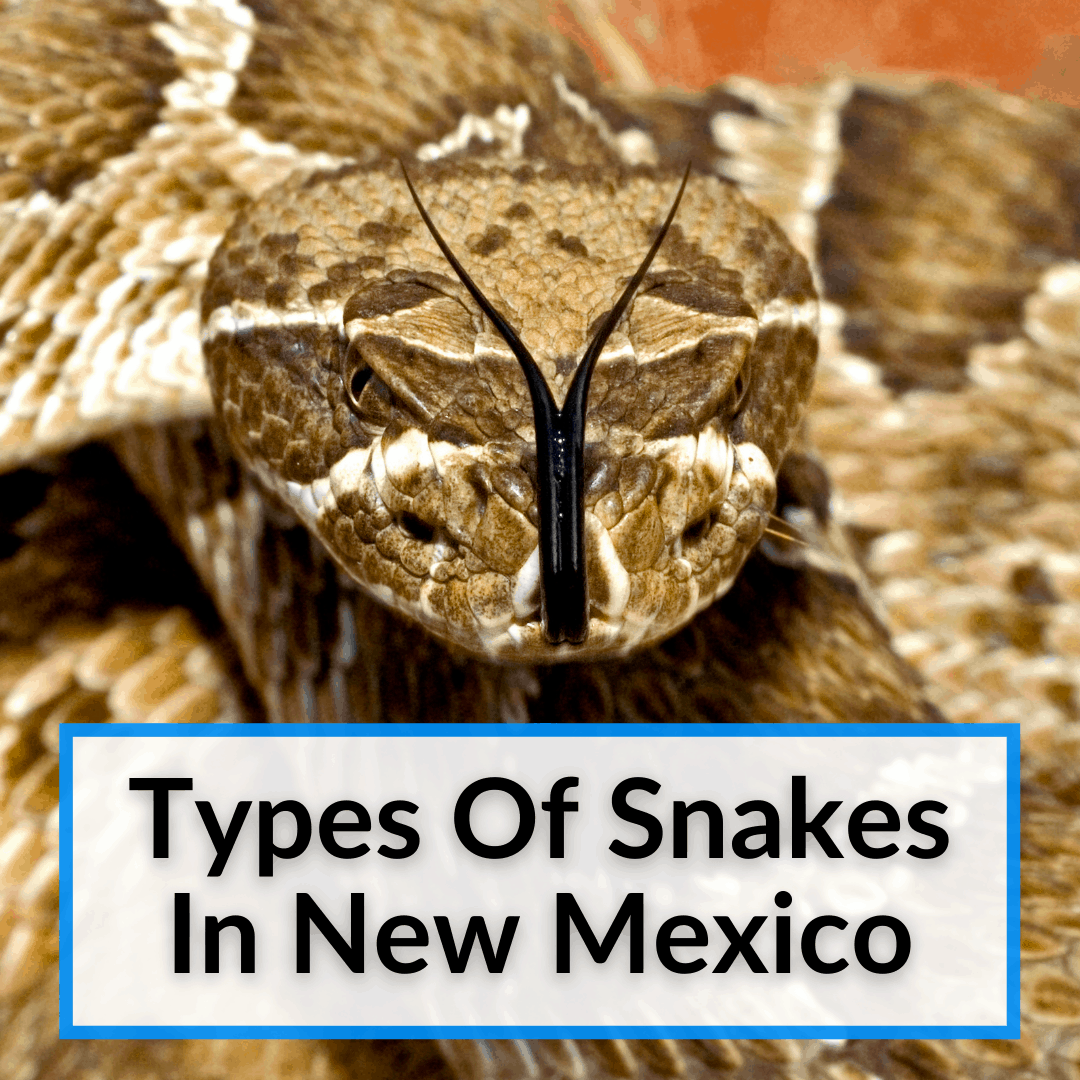
Most of them are not a danger to us, but there are a few venomous species that can seriously injure, or even kill, a human.
That said, even the most dangerous snakes in New Mexico prefer to avoid us, if at all possible.
If you leave them alone, they are only too happy to leave you alone in return.
Of course, it helps if you can identify the different species, so you always know what you are dealing with.
Keep reading for a rundown of the different types of snakes in New Mexico, including a detailed description of each snake’s appearance and behavior.
Table of Contents
- 1 Types Of Snakes In New Mexico
- 1.1 Prairie Rattlesnake (Crotalus Viridis)
- 1.2 Western Diamondback Rattlesnake (Crotalus Atrox)
- 1.3 New Mexico Ridge Nosed Rattlesnake (Crotalus Willardi Obscurus)
- 1.4 Sonoran Coral Snake (Micruroides euryxanthus euryxanthus)
- 1.5 Plains Hog Nosed Snake (Heterodon nasicus)
- 1.6 Desert Striped Whipsnake (Coluber taeniatus)
- 1.7 Chihuahuan Night Snake (Hypsiglena jani)
- 1.8 Gopher Snake (Pituophis catenifer)
- 1.9 Plains Black-Headed Snake (Tantilla nigriceps)
- 2 New Mexico Snakes: Final Thoughts
Types Of Snakes In New Mexico
The following snakes are all species you will encounter in New Mexico. Some are venomous and some are not. Some are common and others are more rare.
Prairie Rattlesnake (Crotalus Viridis)
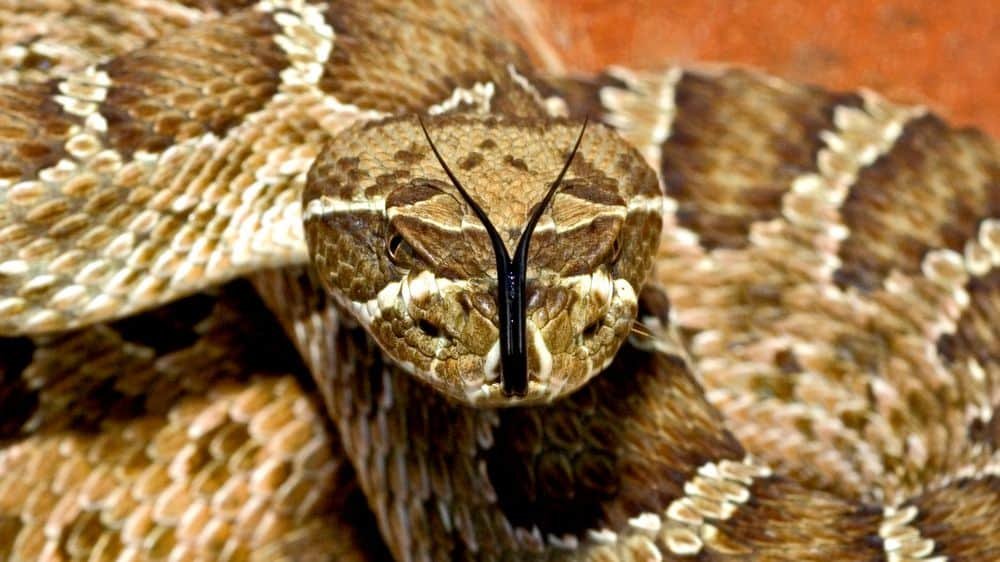
This is the most frequently seen rattlesnake in New Mexico. It is a venomous snake, so keep your distance.
Appearance
Prairie rattlesnakes can get up to 64 inches long and come in a few different color variations. They range from brown, to yellow, to orange-brown, or to even pinkish.
The coloring changes depending on their habitat within New Mexico. You identify them by the big dark-colored spots that run the length of the body. These spots often have a lighter, thin outline.
Behavior
The Prairie rattlesnake is mainly nocturnal during the hot summer but can become more daytime oriented in the nice weather seasons like spring and fall. It will avoid humans if possible and prefers to keep to itself.
Western Diamondback Rattlesnake (Crotalus Atrox)
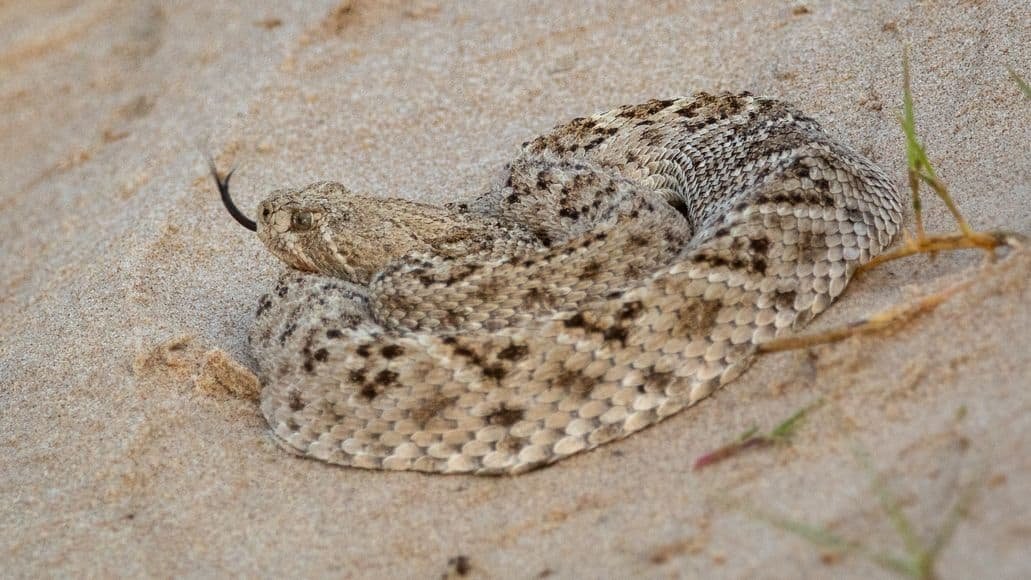
The Western Diamondback rattlesnake is probably the most notorious and feared snake in New Mexico. It is venomous, but it would rather avoid you than strike you. It is the largest of the rattlesnakes in the state and can grow bigger than 4 feet in length.
It is interesting that rattlesnakes end up being the most dangerous snakes in many US states. In fact, they are the only poisonous snakes found in California. For another example, read “Are There Poisonous Snakes In Wisconsin?”
Appearance
Like the prairie rattlesnake, the base color of the Western Diamondback can be either brown, or yellowish, or gray. The easiest way to identify this snake is by the diamond shapes that run the length of its body.
The larger size can also be a good indication you are looking at a Western Diamondback rattlesnake. The end of the tail has black rings around it and, of course, there is a rattle.
Behavior
These snakes prefer to go out at night and avoid the hot sun. They can be seen warming up on a rock in the mornings of the colder months. They can be territorial during mating season and will rear up in a threatening posture if they feel they are in danger.
New Mexico Ridge Nosed Rattlesnake (Crotalus Willardi Obscurus)
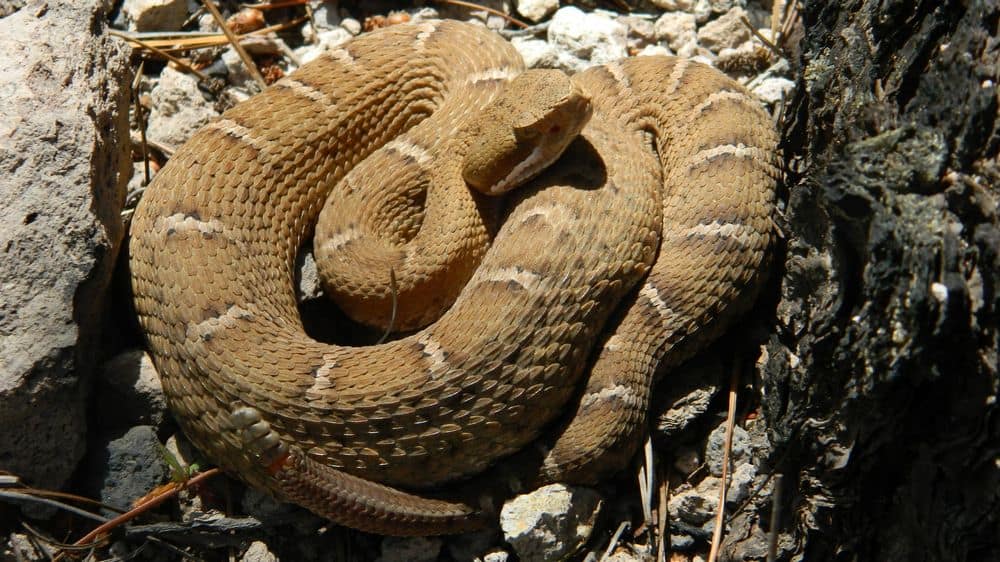
This snake is relatively rare in New Mexico and can only be found in the southwestern part of the state in Hidalgo County.
Appearance
Generally gray, they have distinctive light-colored shapes across their backs that resemble crossbars. They have a raised ridge that runs across their nose, or snout, which is how they got their common name.
Behavior
The ridge nose is shy. They do not like to interact with humans or other animals unless they are hunting or mating. They will avoid confrontation although they will still shake their rattle.
These are venomous snakes and will strike if provoked, but they are less likely to strike randomly than other rattlesnakes in the area.
Sonoran Coral Snake (Micruroides euryxanthus euryxanthus)
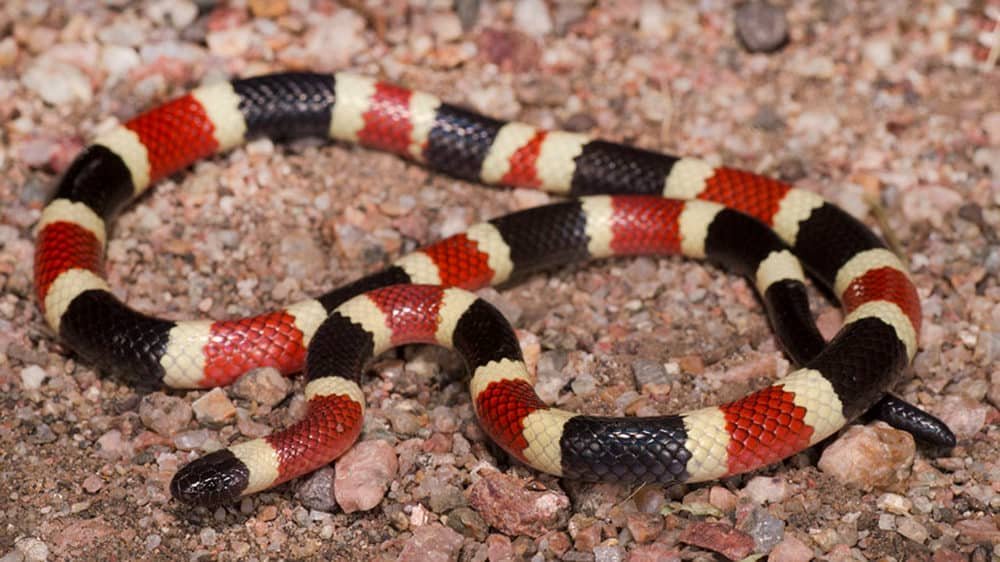
This secretive snake is not a large animal, but it is very venomous and dangerous to humans if you suffer a bite.
Appearance
The Sonoran coral snake only gets about two feet long. It has bright red bands which are adjacent to yellow bands. The end of the snake’s tail will not typically have the red bands. If you see a snake that looks like this, keep away.
Behavior
Like many snakes, this species hibernates in the winter. It comes out of hibernation to breed when the weather starts to warm up.
They are mostly nocturnal and are extremely shy and rare to see. They prefer to stay away from other animals and humans. They like to live near washes or drainage ditches due to the availability of prey in those areas.
Plains Hog Nosed Snake (Heterodon nasicus)
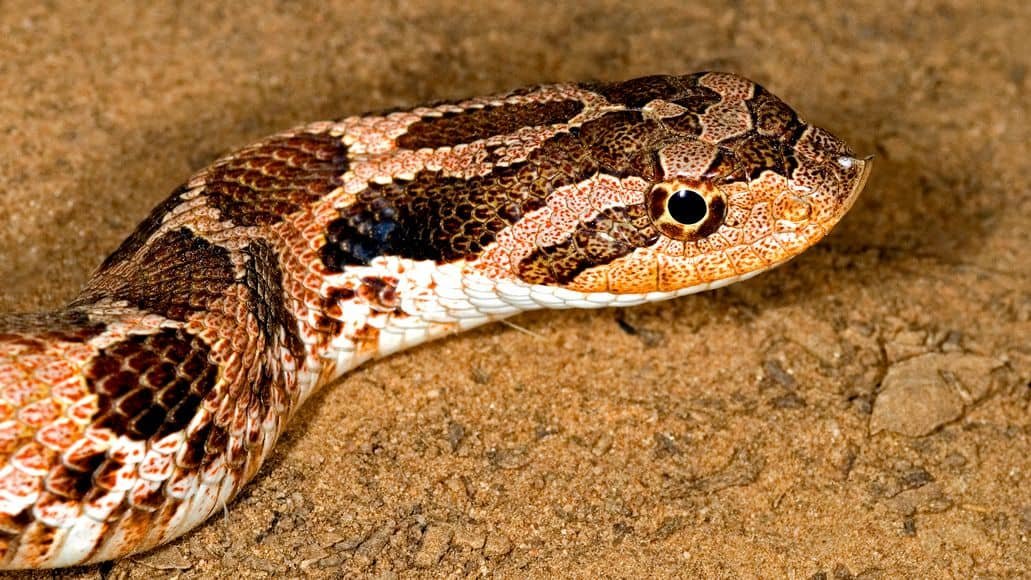
This famous snake is also called by its more frequently used name: the puff adder. It can be found in most of the wilderness in New Mexico.
Appearance
These hognose snakes are usually brown or gray, but sometimes olive, depending on their habitat. They can reach just over two feet in length when fully grown.
They have a series of splotches running along with their bodies that are typically close together. They have fangs but the fangs are in the back of their mouths as opposed to the front like you see on more venomous snakes. They can cause a nasty bite, but the bite is not fatal.
Behavior
Plains hog-nosed snakes do not like the sun very much. They are active mainly in the early morning hours and at sundown when the temperatures are milder.
They feed on amphibians like toads and lizards, as well as eggs and some small mammals. They will bite if provoked and make a hissing sound before they strike. They will avoid humans if they have the opportunity.
Desert Striped Whipsnake (Coluber taeniatus)
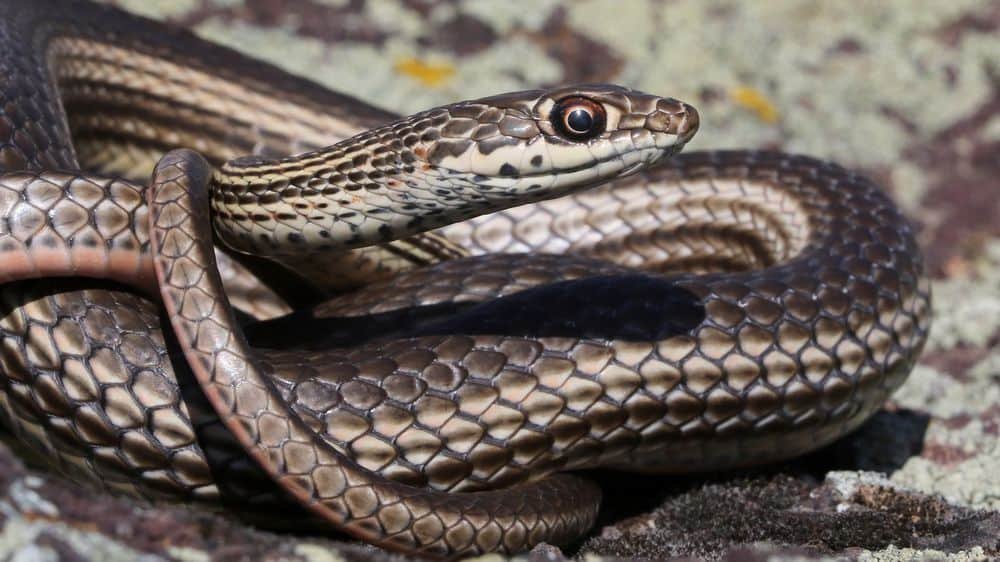
This is a fast snake, and it gets its name from the way it seems to whip across the ground when moving. It is common almost everywhere in the state, and non-venomous.
Appearance
Skinny and brown, and sometimes gray, they have a distinctive light colored stripe that runs along their body. They have round pupils in their eyes and relatively small heads.
The underside of the snake is usually a white or yellowish color. They have smooth scales that give off a shiny appearance in the right light.
Behavior
They are active mostly in the day, unlike most of the other snakes on this list so far. This type of snake is always very aware of its surroundings, due to how vulnerable it is with no venom.
It feeds on mice and frogs and other small animals in the area. They do hibernate in the winter and are known to breed in the warm months following the winter. They are extremely fast-moving and will avoid you at all costs.
Chihuahuan Night Snake (Hypsiglena jani)
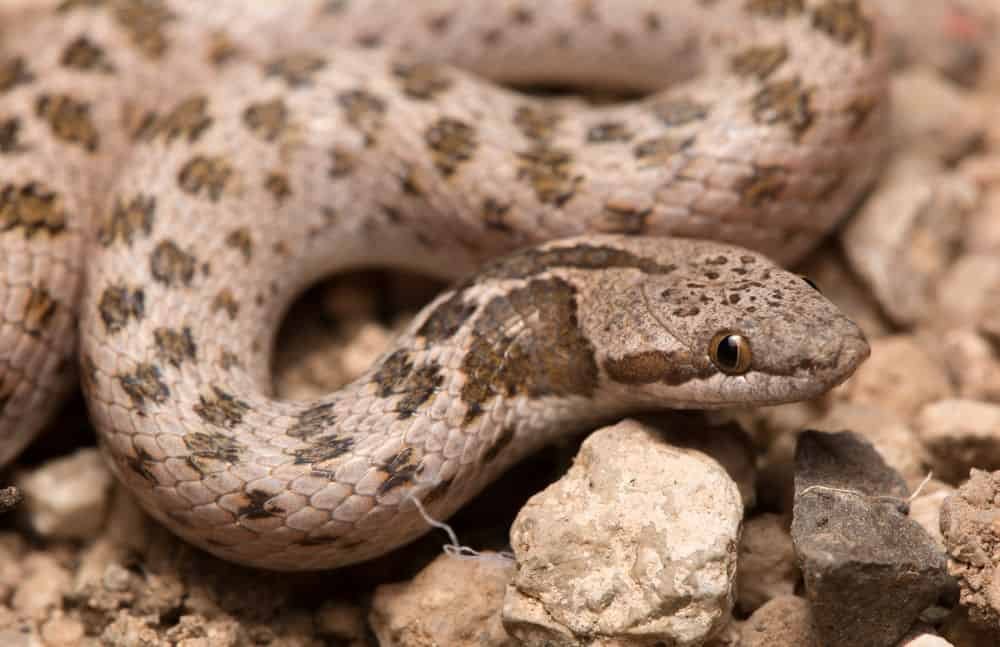
This snake is common in most of the state. They prefer rocky areas, with plenty of crevasses and hiding places to avoid danger.
Appearance
Although they can get up to 27 inches in length, seeing one that big is uncommon. Typically, they are smaller: only about 12 inches long.
They are smaller than many other snakes in the area, and they have small heads. Their skin color varies from snake to snake, depending on the color of the ground in the area. They can be cream, tan, or gray and have spots going down the length of their bodies.
Behavior
Active at night, these snakes are only rarely seen in the daytime. They like to hide underneath rocks and large branches to avoid the sun and predators.
They are usually spotted in the evenings while they are getting ready to go hunting for prey. They prefer to avoid people or any loud creatures that come their way. They are not considered dangerous to humans, but they can bite when threatened.
Gopher Snake (Pituophis catenifer)
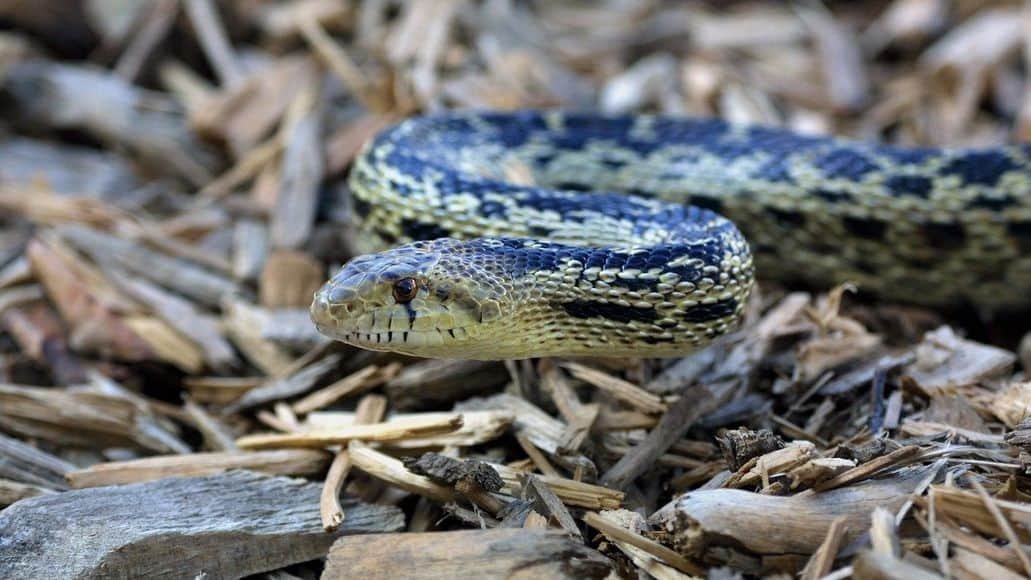
The gopher snake is common all over the state of New Mexico except in exceedingly high elevations. These are sometimes called bull snakes, although the bull snake is actually one specific type of gopher snake.
Gopher snakes and are well known to mimic (and are often mistaken for) rattlesnakes. They look intimidating but they are not interested in attacking you.
Appearance
Quite possibly the largest snake on this list, a full-grown gopher snake can grow longer than seven feet in the wild. This is extremely large.
Most mature adults are about four feet in length, but the big ones are out there, too. They are tan or yellowish, or sometimes reddish-brown, depending on the area in which they live. They often have black or dark brown spots or randomly shaped blots on their bodies.
Behavior
They are generally gentle snakes, but have been known to be dangerous when cornered. They will coil up and shake their tail when agitated, which can sound like a rattlesnake if you are not familiar with gopher snakes. They hibernate in the winter and emerge to breed and lay eggs when the weather warms up.
Plains Black-Headed Snake (Tantilla nigriceps)
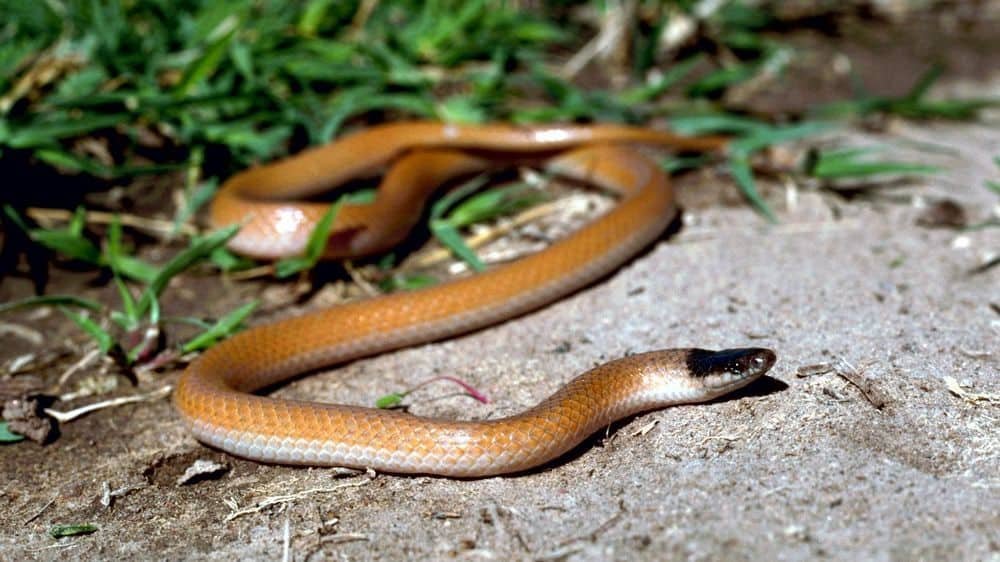
Common mostly in the southern parts of New Mexico, the plains blackhead is a small snake. It is a venomous snake, but the venom is meant for small prey and is not typically dangerous to humans. They are extremely secretive little snakes and spotting one in the wild is not a common occurrence.
Appearance
As the name suggests the head is black, or very dark brown, and looks like a cap or face mask. It has very smooth scales which can give the appearance of being shiny or wet, but these snakes are not water dwellers.
They are usually tan or brown and have an orange or reddish-pink line going down the length of their underside. If you see a shiny brown snake with a black head, it is a plains black-headed snake.
Behavior
They eat mostly large insects like spiders, grasshoppers, scorpions, and other small prey. When they are done breeding, they lay a small group of eggs, usually up to 3 eggs total.
They are active in the daytime mainly, but in some areas, and for some reason, they have been known to be active at night as well.
They prefer to live a fair distance from trails or riverbeds or any other feature that attracts animals. Their favorites are scrub flatlands and creosote bushes. They will avoid humans if they can and will escape long before they try to bite you.
New Mexico Snakes: Final Thoughts
Now you know the species of snakes you are most likely to encounter in New Mexico. As you can see, most are not a danger to humans. And even the dangerous ones would prefer to stay out of our way and will only attack if threatened.
As always, keep your distance and you will be fine. Even if you are sure a snake is non-venomous, there is no good reason to get close enough to provoke it.
Bud says
I came across a nearly a white 4′ long snake this past spring. It was a cold and obviously was seeking warmth in our Dog run., next to the house. Wasn’t a threat since hardly moving… I put it back in the adjacent desert… any idea what it could’ve been? Thanks!
Gordon Wilson says
Hard to say. Maybe a Kingsnake? There is always a good chance it was someone’s pet that they got tired of and just released somewhere.